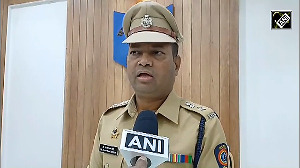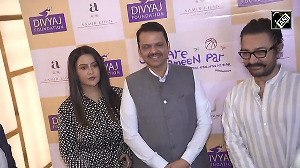Shobha Warrier meets Sabriye Tenberken who is changing lives in India.
Blindness didn't stop Sabriye Tenberken from seeking adventure. In fact, it motivated her to get others like her -- the marginalised -- to do the same.
Her dream brought her to Kerala, where she and her partner Paul Kronenberg launched kanthari, a leadership programme that empowers those from the marginalised parts of society from all over the world to initiate social change as entrepreneurs, innovators, and activists.
I meet Sabriye in the sylvan surroundings on the banks of the Vellayani lake in Thiruvananthapuram -- where the institute stands. Sitting in the open -- surrounded by trees, and with her dog lying close to her feet -- she shares her inspiring story.
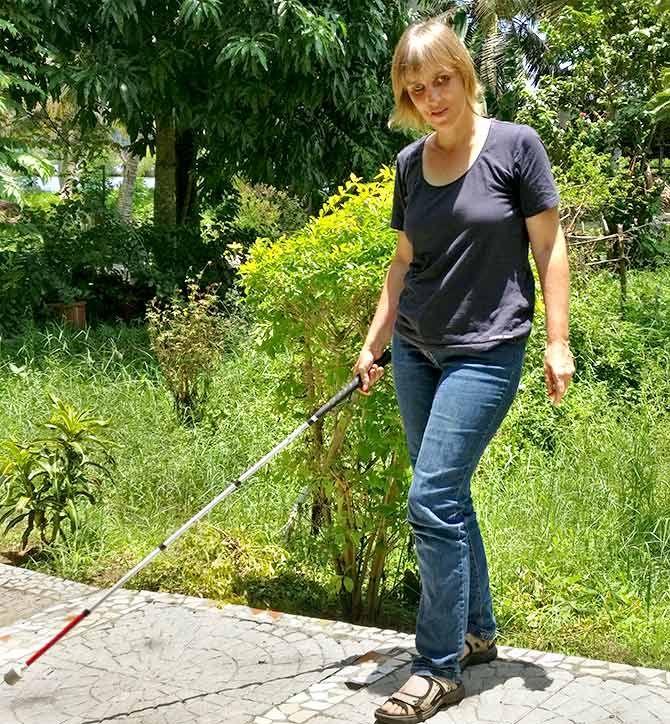
She says the biggest problem she faced was not the fact that she was becoming blind, but the experience of being isolated by society.
Photograph: Shobha Warrier/Rediff.com.
When I could see
I grew up in Morenhoven, a very quiet village close to Cologne in Germany.
My father was a pianist and my mother a theatre director.
When they were young, they had started a school for social change -- a creative school to groom children as critical thinkers through drama, music and art.
The school was a hub where children from rural areas could learn to be creative so that they evolve as creative doers and critical thinkers.
The school taught the children to dream, and, thus, to shape their own future. So, most of us were able to dream fearlessly.
I am also living my dreams.
There was a time in my life when I could see pretty well. I could read with the help of strong glasses. I could write. I could ride a bicycle...
Most didn't know that I had an eye problem, but my eyesight was slowly deteriorating, and I started realising this when I was 9.
The biggest problem I faced was not the fact that I was becoming blind, but the experience of being isolated by society.
The kids who were my friends till then were not my friends anymore. I was excluded from all activities, and this was quite traumatic.
The time was so difficult that I stopped talking, even to my parents. I was an extrovert till then but after I became blind, I became an extreme introvert.
I was angry, sad and deeply, deeply hurt.
I didn't blame my situation on blindness; I blamed it on all kinds of things like I was not nice enough, I was stupid, I was maybe talking too loud.
While the kids isolated me, the adults treated me with pity, which I could not understand. I asked myself, 'Why me?' and this made me even more angry.
Looking back, I feel my parents reacted in a very good way.
They were never over protective. Never. They always let me figure out my own borders, which is extremely important for a disabled kid.
I see many parents of disabled children become very overprotective and won't let their disabled children try out new things. That was never the case with me.
My parents empowered me in such a way that they always said, 'Try it out yourself; find your own ways'.
If they had interfered, I would have got the feeling that I was not strong enough to face the world on my own.
A turning point
Every evening they read a lot of books to me.
One of the books was about the black power activist Angela Davis. Her life had such a strong impact on me that I got very interested in the civil rights movement.
I was able to empathise with Afro-Americans who had difficulties finding their own identity. Many tried to lighten their skin or straightened their hair out of fear of not belonging to white American society.
I too experienced this fear, being a blind child amongst sighted. I did everything so that my lack of sight would not be too obvious.
At 12, I decided that two years of being an introvert were enough. This was not me. I felt a lot of energy that was needed to get out of the box.
After that, I started using the term 'blindness' as a magic word. I could explain my situation without feeling awkward.
Every time, I bumped into someone, I could say, 'Sorry, I am blind'!
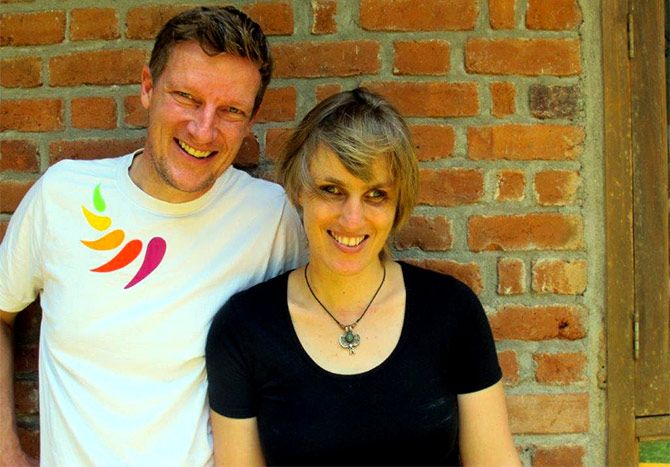
Photograph: Kind courtesy Paul Kronenberg
Going to a school for the blind
With this revelation, I decided to study in a higher secondary school for the blind.
I can say now that I have not seen a similar school anywhere else in the world.
It's a school where we were taught at least four foreign languages; English, Latin, French and Italian.
We also had excellent science courses and most classes were interdisciplinary: Maths, philosophy, history and politics.
Our teachers had high expectations in regards to academic subjects, but there was also a strong emphasis on sports.
We learned skiing, horseback riding, voltage (acrobatics on a moving horse), and water sports; my favourite was white water kayaking.
We learnt all these techniques to gain confidence and experienced how sport opened the door to the world.
It was in this school where I learnt to use a cane, read Braille and other daily living skills like cooking, cleaning, etc.
Since it was a boarding school and we lived in flats, we had a very independent life, learning everything from managing the money to buying things and cooking.
In no time, I was back to being an extrovert.
Once my confidence was back, I made lots of friends again.
One day, when school was about to end, our philosophy teacher asked us, 'Is there a life after your Abitur (the final exam, which leads to university)?'
His question made me think. I sat down to make a whole list of things I wanted to do after my Abitur: My dream projects.
On top of the list was 'I wanted an adventurous life.' I wanted to learn many languages. I wanted to travel outside of Germany alone. I also wanted to be a writer.
Knowing my interests, my teacher asked me, 'Why don't you do development work?'
I went to the Red Cross to ask whether I could do an internship. As expected, they said they would be going to difficult areas and as I was blind, I would be a burden on them!
Then I thought if they could not take me, I would start my own organisation, and I could send myself into the field.
Going to Tibet alone
I chose Tibet because of its altitude, blue sky, mountains, horses and white waters.
I had learnt to read the Tibetan script in high school, and I had decided to study Tibetology in university. During my studies, I had also created the Braille system for Tibetan language.
Right before I started my masters in Tibetology, I travelled to Tibet on my own.
Travelling with a sighted companion has a lot of disadvantages. People tend to talk only to the sighted person; they just ignore the blind. I didn't want that to happen.
In Tibet, I travelled on horseback through villages, and the villagers were intrigued to see a blind person on a horse. They said, 'You cannot be blind. How can a blind person ride a horse?'
I explained that the horse could see; only I can't.
It was in Lhasa that I met my life partner, Paul Kronenberg.
The funniest thing was, he was coming from a place in Holland, quite close to where I lived, but we met far away in Tibet!
We connected very quickly as we shared a lot of similar ideas. This was in July 1997; we have been together till now.
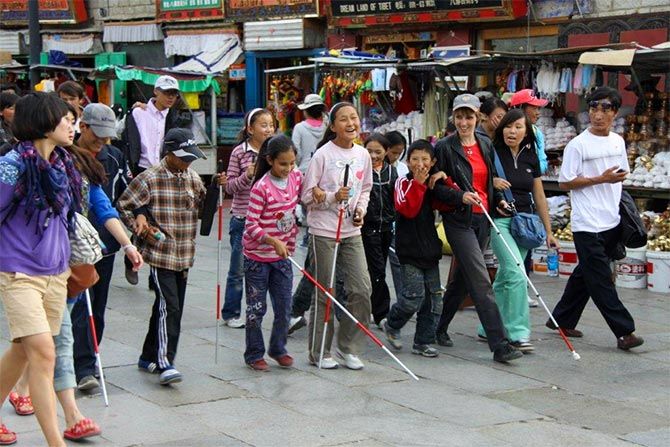
Photograph: Kind courtesy Paul Kronenberg.
Starting a school for the blind in Tibet
My plan was to start a school for blind children in Tibet where I wanted to prepare them to go to regular schools.
Paul happily joined me in this endeavour.
We are a good combination -- Paul is an inventor who can build anything from technical equipment to beautiful houses, while my skills are more in creating academic programmes and curricula.
The most important thing is both of us are doers.
In the meantime, I also realised my dream of becoming a writer. In 2000, I wrote my first book, My Path Leads to Tibet, which luckily became a bestseller in Germany. It was translated into 16 languages.
From the royalties, we could buy a house for our school.
We started with six children. When we moved to the city, we had 11. After one year, we had 35 students.
We decided to limit the number to 35 so that we could get them ready to go to regular schools or start working after spending two or three years with us.
We taught them Braille reading and writing in three languages (English, Tibetan and Chinese), computer skills, cooking and mobility with the white cane.
In the regular school, our children were far ahead in languages, which gave them a great privilege. The blind were often the only ones who could write essays in Tibetan.
They were not objects of charity, but contributors.
In fact, they integrated themselves into regular schools without many difficulties. While they received help from the sighted, they were able to help their sighted classmates.
In 2004, we started a vocational training farm for adults where we had a massage clinic, cheese manufacturing, organic farming, handicrafts and an animal husbandry unit with cows, horses, pigs, etc.
The funding for all these activities came partly from China and the rest from outside China.
On our 10th anniversary, some Chinese journalists did a study of our students -- on what they dreamed of while joining our school and what they achieved later on in life.
The journalists found that most of our students chased their dreams, realised them, and were quite successful in life.
Some of them ran business ventures like schools, kindergartens, etc.
It made them wonder how they became so efficient in their lives and how they became the breadwinners in the family despite their marginalisation.
The blind are indeed the most marginalised in Tibet as blindness is seen as a kind of punishment for what a person must have done in her/his previous life.
We make them see that the most important thing is to chase one's dreams while embracing limitations. This is exactly what they did.
The next step
That was when we thought of creating a centre for the marginalised so that they could realise their own dreams, rising above the adversities. We call it "the change from within".
Change happens from people who have experienced adversity.
For example, Gandhi faced discrimination when he was thrown out of the train and from there started his fight against racism.
In my case too -- if I had not become blind, I would have continued living in Germany perhaps, working as a lecturer. It was my blindness that brought me here, chasing my dreams.
If the blind kids from Tibet can jump back into society with so much confidence to make a difference, all the others out there in the world can too.

Photograph: Shobha Warrier/Rediff.com
Coming to Thiruvananthapuram
When we shared this idea with a New York Times journalist, we also mentioned that we wanted to be in the south of India.
It is for us the most central place in the world. The south Indian tip looks like a spring board. This for us was the right space from where change makers can jump to any part of the world to make a difference.
We wanted to be in Kerala and the picture we had in mind was that of water, greenery, coconut trees and a lovely breeze.
The NYT journalist did not write Kerala; he only mentioned south India as our destination.
One person from Thiruvananthapuram, Navin Ramachandran, who was about to quit his job in the United States happened to read the story by accident, and contacted us. He invited us to his native place and showed us around.
Here we started looking for a suitable space -- the place we had in mind had to be near water. We found this plot on the banks of the Vellayani lake. It was the 49th plot we saw.
It was affordable and exactly what we had imagined.
Initially, we decided to call it the International Centre for Social Entrepreneurs.
But I was never happy with this name, because social entrepreneurship is not the only way to create sustainable social change.
In fact, we found at least five different equally effective types of social change agents. We needed a term that would cover all these different types.
A bite of Kanthari
Then one day, it happened.
I bit into a chilli, a tiny chilli that looked harmless and small, but I was jumping up, as it turned out to be so spicy!
I was told it was a "Kanthari", a specific bird's eye chilli that grows in Kerala, in every backyard.
This was exactly the symbol we were looking for.
A Kanthari is small, but highly effective. It grows in the wilderness. Therefore, it is the perfect symbol for someone from the margins of society, someone who has fire and spice or the guts to challenge the status quo.
The Kanthari chilli has medicinal properties as well: It lowers blood pressure, purifies, can make you alert much more than coffee and it is a pain killer too.
Just like a social change maker, it leaves something positive behind.
A marginalised person could be anyone from anywhere in the world. They could be former street children or former sex workers; they could be HIV positive; they could be disabled or blind...
And just like the Kanthari chilli, they are fiery, a little crazy, confident and usually swimming against the stream.
We liked the name and the way it sounded so much that we decided to name our project kanthari with a small 'k'.
The Kanthari chilli comes in at least five different colours. This gave us the idea to dedicate each colour to a specific type of change maker.
We tailored our curriculum based on these five colours of kanthari to train them to become entrepreneurs, initiators, inventors, activists and artists.
The red ones, the spiciest, denotes activists or advocates.
Green is for initiators, those who start training centres, environmental projects, health projects, HIV projects, etc.
Yellow kantharis are inventors, the ones who create new technology for the marginalised.
Orange kantharis are social entrepreneurs.
The purple ones are artists like my parents who made change through art.
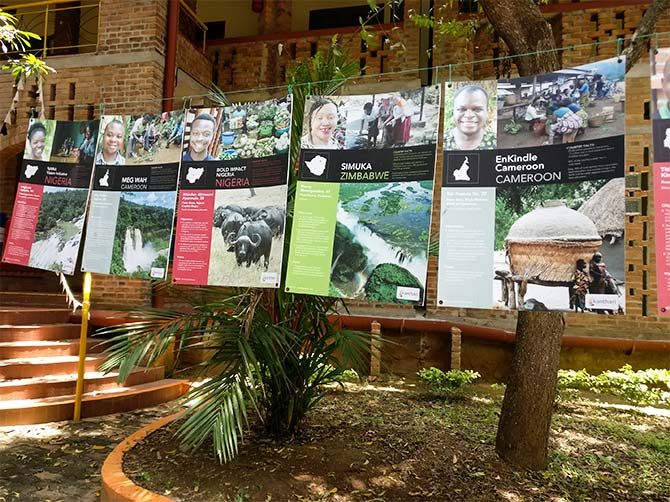
Photograph: Shobha Warrier/Rediff.com
The making of a kanthari
Last year, we had around 360 applicants and from that, we chose 24. So, it is not easy to get in.
Those selected for training do not have to pay any fees for the seven-month course as they are sponsored by various organisations from around the world through scholarships.
But we insist that they arrange their transport to Kerala, and also take care of their visa fees. That is because we want them to take some effort to undergo the training and we feel it also shows their ability to do fund raising.
The difference between our training centre and other centres is that we have no pre-condition on education.
Even those without a high school diploma can come and train themselves here, if they know English and how to use computers -- of course, only if they have a dream project in mind and the passion and stamina to realise this dream.
Additionally they should be able to overcome adversity.
For example, a blind person from Uganda, who after being trained at kanthari started a honey co-operative while training blind persons in bee keeping. He makes money, which of course makes him a social entrepreneur.
His main focus, however, is social change; income is just a welcome side affect.
Because of his social venture, a huge change in the attitude of society towards the blind was created.
This, I feel, is real social entrepreneurship, social change happening through entrepreneurship.
After successful completion of the course, to start or successfully run their already existing projects in their area, the participants receive a stipend of $400 for five months. This stipend will help them to focus full time on the start up of their project and on fund raising.
Kantharis so far...
Not all who come to be trained here are entrepreneurs. A lot of them become campaigners, fighting for gender justice, against discrimination, for human rights.
So far, 160 kantharis from 38 different countries in the world have graduated from here, and 125 of them are successfully running their own programmes.
We, Paul and I, are happy here in Thiruvanathapuram.
We want to continue our work for many more years.
Later on, we would like to find a team, maybe kantharis themselves to run this.
Then I would like to travel again to experience the work of kantharis in the margins of society.










